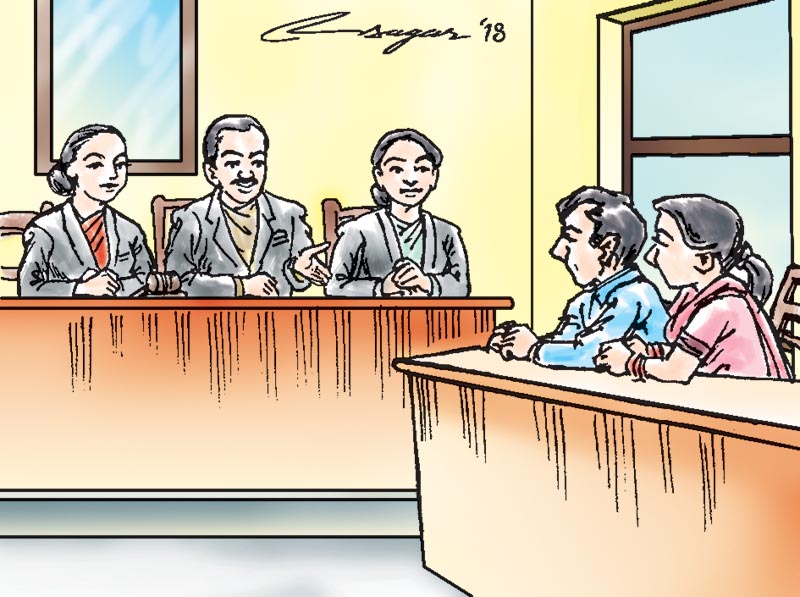Judicial committees: The teething problems
There have to be multi-pronged interventions to empower the local level judicial committees so that they can operate in the spirit of the constitution and ensure justice delivery for the ordinary people
The right to get justice is one of the most fundamental rights of a human being. But for ordinary people, justice has become almost inaccessible for various reasons. A recent study by the Nepal Law Society (NLS) shows that out of total disputes, only around 15 per cent tend to be registered in proper court and judicial authorities. Even then, there are around one lakh pending cases at different levels of court.
Against this backdrop, the issue of justice at community or “justice at doorsteps” has been one of the key challenges. The practice of local justice dispensation is not new in Nepal. After the 1990 constitution and the subsequent Local Self Governance Act 1999, there were local agencies recognised as quasi-judicial bodies, and the practice of community mediation too gained ground.
The new constitution promulgated in 2015 has taken a big step forward in this direction. To overcome the inefficiencies of the formal system, increase access to justice and bridge the formal/informal justice divide, the drafters of the constitution envisioned judicial committees at each of the 753 municipalities and rural municipalities.
Headed by deputy mayor at the municipal level and deputy chairperson at the rural municipal level, as per Article 217 of the constitution, the three-member committee has the mandate to adjudicate, arbitrate and refer cases for mediation at the local level.
Similarly, Local Government Operation Act (LGOA) 2017 was enacted to implement the provisions related to the powers of local levels as per the constitution; to promote cooperativeness, co-existence and coordination among the federal, provincial and local levels; to institutionalise the legislative, executive and judicial practice at the local level; and to deliver efficient and quality services by ensuring people’s participation, accountability and ensure transparency.
As per Clause 47 (1) of LGOA, judicial committees are empowered to settle disputes related to 13 specific matters. Likewise, as per Clause 47 (2), in 11 other matters, judicial committee has the right to settle the disputes through mediation. However, the disputants can also directly register the cases at the court in the cases under Clause 47 (2). Likewise, the disputants can appeal at the district court if they are dissatisfied with the committee decisions. In case of adjudication and arbitration, judicial committees collectively exercise their jurisdiction, and the opinion of the majority is regarded as the decision of the committee. In cases of mediation, judicial committees keep a roster of mediators and refer the parties to the mediation centres at the ward level.
The members of the committee are primarily the elected political representatives who now have to act as “judges” on certain specified matters. But hardly two per cent of committee members have legal background. As these committees have started operating and hearing cases, a recent monitoring visit was undertaken by the NLS at local levels in Saptari, Dhading and Kavre districts. Some key observations are listed here.
Although the law has given the local level judiciary committee 13 rights for decision making and 11 rights for settlement through mediation, people were reaching out to them for settling disputes other than the 24 specified areas as well. Similarly, due process according to the spirit of the law was not followed. Very rarely did the committees follow step-by-step process such as accepting application, recording of statement, collection of evidence and decision making/ execution.
No separate institutional/administrative mechanism was available to judicial committees. Doubts were also raised about the execution of decision by judicial committee in places where the chair of the committee and the local level executive come from different parties. Most of the local levels were found to have exercised the power of mediation themselves instead of mobilising the local level mediators as per the law.
In the absence of regulations on the LGOA, these committees lack clarity, institutional capacity and coherent policy framework. There have to be multi-pronged interventions to empower the local level judicial committees so that they can operate in the spirit of the constitution and ensure justice delivery for the ordinary people.
First, the laws should clarify whether the local level judicial committees are merely quasi judicial bodies or local courts. Second, clear and unambiguous set of rules, procedures and guidelines have to be formulated so that there is a set protocol the committees can follow while adjudicating. Third, the office-bearers of judicial committee must be provided with basic legal training to build their capacity and confidence. Fourth, Clause 47(2) of the LGOA clearly states that the judicial committees must settle the 11 specified matters through mediation. For this, the committees have to refer the disputants to ward level mediation centres which are non-existent at present.
There is a constitutional provision that local level legislatures should formulate the rules, procedures and guidelines. They will require resource and knowledge support. That can be the stepping stone towards the successful operation of judicial committees. Their success is also inter-linked with the success of federalism and the new constitution.
Pradhan is executive director of Nepal Law Society






